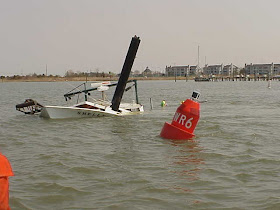Excerpt from U.S. Coast Guard Proceedings of the Marine Safety & Security Council magazine by Mr. Robert Trainor, aids to navigation specialist, U.S. Coast Guard Office of Navigation Systems.
Aid availability for the United States visual aids to navigation system is calculated monthly by the U.S. Coast Guard Marine Transportation Systems Management Directorate’s Visual Aids to Navigation Division.
Frequent updates and convenient data presentation lead many waterways managers to assume that aid availability provides a comprehensive assessment of the health and effectiveness of aids to navigation (ATON) in their waterways as well as the efficiency of their ATON service delivery units. This mistaken assumption has perpetuated the following aid availability myths:
- Aid availability is proportional to recurring ATON funding levels.
- Aid availability provides an accurate assessment of an ATON service delivery unit’s efficiency.
- Unscheduled maintenance of ATON service delivery platforms (cutters and boats) or emergency diversion to other mission areas directly impacts aid availability.
- Aid availability is primarily impacted by ATON component reliability.
Dispelling the Myths
Myth—Aid availability is proportional to recurring ATON funding levels. This is predicated on the assumption that recurring funding levels could be reduced if aid availability goals were lowered. The efficiency by which the USCG corrects ATON discrepancies directly impacts aid availability, so lowering aid availability goals would suggest that the Coast Guard should reduce its efficiency.
Furthermore, being less proficient at periodic maintenance or ATON discrepancy response would likely result in a much greater expense when the discrepancy is eventually corrected.
In addition, timely response and correction of an ATON discrepancy could help prevent a much costlier incident, such as a vessel collision or grounding.
Myth—Aid availability provides an accurate assessment of an ATON service delivery unit’s efficiency. This myth equates a falling or raising aid availability with the efficiency of an ATON service delivery unit. While a service delivery unit’s efficiency could certainly impact aid availability, there are a variety of other factors that could have a greater influence.
Myth—Unscheduled maintenance of ATON service delivery platforms or emergency diversion to other mission areas impacts aid availability. The USCG’s ATON multi-tiered maintenance strategy provides reserve capacity, including primary and secondary service delivery units, for these and other contingencies.
Myth—Aid availability is primarily impacted by ATON component reliability. This assumes that an increase in ATON component failures (power systems, optics, buoys, mooring chain, dayboards, etc.) has a direct impact on the aid availability rate. However, an analysis of discrepancy data over the past 10 years does not support this assumption.
While component failures certainly influence discrepancy rates and may influence aid availability, the data does not support a direct correlation.
 |
A temporary lighted buoy marks the wreckage of a lighted beacon, which was damaged after a vessel allision. |
The Continuing Mission
To appropriately focus their resources, waterway managers must carefully measure the state of the aids to navigation systems under their purview. Aid availability rate is just one of the tools they use.
We must be mindful, however, to consider this information in perspective and in conjunction with other metrics to accurately assess overall waterway ATON health and effectiveness.
 |
PERCENT OF DISCREPANCIES CAUSED BY COMPONENT FAILURE. |
Find out more in part 2.
Full article is available at http://www.uscg.mil/proceedings/spring2011/.
Full article is available at http://www.uscg.mil/proceedings/spring2011/.
Subscribe online at http://www.uscg.mil/proceedings/subscribe.asp.
No comments:
Post a Comment
Comment Policy
We welcome your comments on postings at all Coast Guard sites/journals. These are sponsored by the U.S. Coast Guard to provide a forum to talk about our work providing maritime safety, security and stewardship for the American people to secure the homeland, save lives and property, protect the environment, and promote economic prosperity.
Please note: Anonymous comments have been disabled for this journal. It is preferred that you use your real name when posting a comment. WE WILL POST THE NAME YOU ENTER WHEN YOU SUBMIT YOUR COMMENT. Also, you are welcome to use Open ID or other user technologies that may be available.
All comments submitted are moderated and will be reviewed before posting. The Coast Guard retains the discretion to determine which comments it will post and which it will not. We expect all contributors to be respectful. We will not post comments that contain personal attacks of any kind; refer to Coast Guard or other employees by name; contain offensive terms that target specific ethnic or racial groups, or contain vulgar language. We will also not post comments that are spam, are clearly off topic or that promote services or products.
We will make our best effort to promptly post those comments that are consistent with the Comment Policy, but given the need to manage federal resources, moderating and posting of comments will usually occur only during regular business hours, Monday through Friday. Comments submitted outside of business hours will be read and posted as quickly as possible.